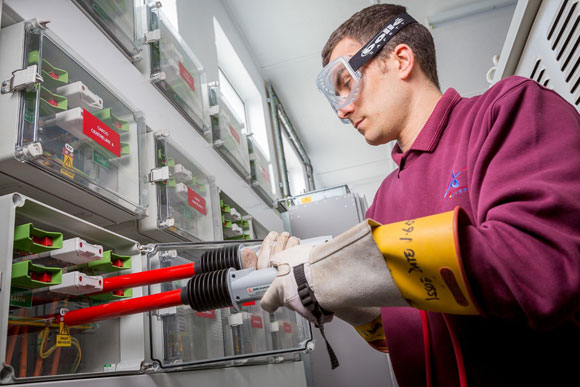Innovative test instrumentation is helping a busy airport to ensure that important electrical maintenance work can be carried out safely and efficiently in compliance with aviation industry regulations.
The engineering team at Jersey Airport in the Channel Islands is using specialist Seaward AGL- 5 voltage indicator equipment to ensure that airfield ground lighting circuits have been isolated from the power supply before essential maintenance and inspection work is carried out.
Thousands of metres of cabling provide the power to Jersey Airport’s runway, taxiway and apron lighting systems that guide aircraft during take-off and landing operations.
Airfield Ground lighting is supplied by series circuits, with separate circuits for different lighting systems providing a failsafe mechanism to ensure their continued operation.
The series circuits are controlled by constant current regulators (CCR), designed to ensure that at a stable power output, provides consistent luminescence levels across the network.
As the lighting systems are designed to maintain constant lamp brightness under all conditions, the outputs of the units are not equipped with any RCD or other safety trip mechanisms. If present, when activated, these would result in a loss of power, extinguishing all lamps on that particular circuit - something that clearly needs to be avoided, for example, when an aircraft is coming in to land during darkness.
To maintain effective operating conditions the engineering maintenance team at Jersey Airport constantly monitor the field lighting circuits to check for any deterioration in cable insulation and lighting performance; for example, damage to the underground cables from indigenous wildlife can sometimes cause problems.
The team uses any trends highlighted during the monitoring to identify trigger points requiring formal maintenance work and this requires a powering down of system so that any repairs or remedial measures can be carried out safely.
In compliance with the Civil Aviation Authority’s CAP 168 regulations, Jersey Airport’s engineering services team follows formal in-house safety rules and working procedures to ensure that all runway and airfield lighting circuits are isolated from the power supply before any maintenance or inspection work commences.
The Seaward AGL-5 voltage indicator system has been specifically designed to meet this ‘proving dead’ requirement and comprises a dedicated two pole voltage detection system capable of identifying the presence of voltages on systems from 50V to 5KV.
Operation and control of the ground lighting systems at Jersey Airport is maintained by three on-site substations. Ahead of all electrical work, after switching off and locking out the CCR units, the AGL-5 is used to make contact with the cable termination points of the field circuits to verify safe working conditions.
For ease of connection to electrical terminals, the AGL-5 test rods are equipped with tapered contact points and the ‘no go’ presence of voltage in the lighting circuit is indicated by the illumination of high intensity red LEDs. A polarising filter also makes the voltage indication clearly visible in all working environments and conditions.
Jersey Airport saw a 3% increase in passenger numbers during 2014 taking the total to nearly 1.5 million people. With growing visitor numbers, a team of seven airfield electrical technicians monitor and maintain the airfield’s ground lighting systems to ensure the continued and ongoing operation of the runways and associated areas.
Peter Page, Engineering Services Manager, at Jersey Airport, said: “Ground lighting systems have to perform at optimum levels to ensure that aircraft can use the approach, runway and apron areas at all times – and responsibility for this critical need rests with the airport electrical maintenance, service and lighting teams.
“Working with what can be potentially dangerous high voltage electrical circuits means that proving dead is essential to ensure safe working conditions and failsafe maintenance practices.
“The Seaward AGL-5 allows us to meet this requirement safely, efficiently and effectively – enabling important airfield work to be undertaken without delay and disruption to important airport schedules.”

















Sign up to our Newsletter.
Stay up to date with the latest industry and product news, as well as our free educational content such as webinars and our expert guides.
Close